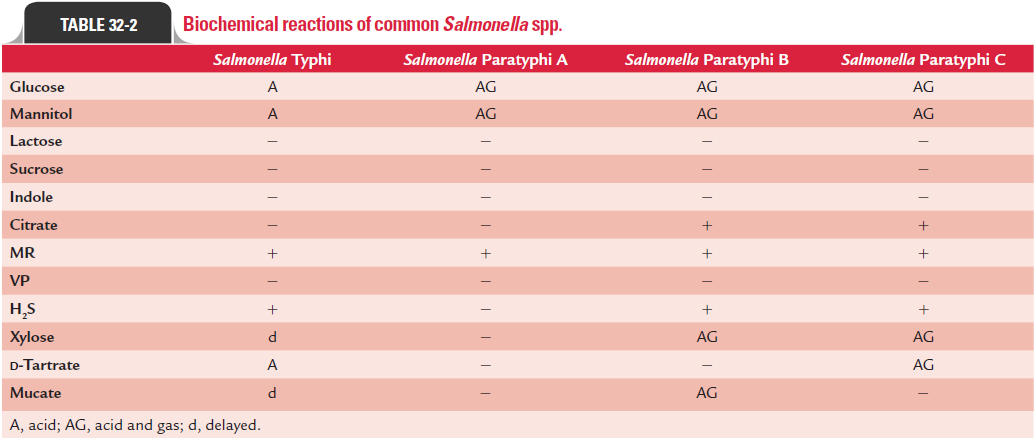Chapter: Microbiology and Immunology: Bacteriology: Salmonella
Salmonella: Properties of the Bacteria
Properties of the Bacteria
◗ Morphology
Salmonellae are Gram-negative bacilli measuring 1–3 m in size. They are motile with the presence of peritrichous flagella (SalmonellaGallinarum and Salmonella Pullorum are exceptions, which are nonmotile). They do not form spores and capsules. Some strains of salmonellae may produce fimbriae, but most strains ofSalmonella Paratyphi A and few strains of Salmonella Paratyphi B, Salmonella Typhi, and Salmonella Typhimurium are nonfimbriated.
◗ Culture
They are aerobic and facultatively anaerobic; they grow at an optimum temperature of 37ºC in a pH of 6–8 on a variety of nonselective (Mueller–Hinton agar) and selective (Wilson and Blair’s bismuth sulfite medium) media.
1. Nonselective solid media: Onnutrient agarandbloodagar,Salmonellaspp. produce gray white moist colonieswith smooth convex surface after 18–24 hours of incuba-tion. Rough strains produce opaque and granular colonies with irregular surface. Some strains ofS. Paratyphi B produce large mucoid colonies due to the production of loose polysaccharide slime. On MacConkey agar, they produce pale colorless colonies because they do not fer-ment lactose. S. Typhi do not grow on this medium. The colonies ondeoxycholate citrate agar are similar to those produced on MacConkey agar. Sometimes after incuba-tion of 48 hours or more, they produce colonies with a black center.
2. Selective solid media:Wilson and Blair’s bismuth sulfiteagar is the medium of choice forSalmonellaspp., especially S. Typhi. The growth of Shigella spp.,Proteus spp., andcoliforms is inhibited on this medium. On this medium, salmonellae produce jet black colonies surrounded by a metallic sheen due to production of hydrogen sulphide. S. Paratyphi A and other species, which do not produceH2S, form green colonies. XLD (xylose, lysine deoxycholateagar) is another selective medium used for isolation ofSalmonella spp. On this medium,Salmonella spp. producepink colonies with black centers as a result of H2S produc-tion. H2S-negative Salmonella serotypes produce red colo-nies without black centers.
Liquid media: Selenite F and tetrathionate broth arecommonly used enrichment media. Selenite F broth is fre-quently used for enrichment of Salmonella spp. from clini-cal specimens. However, sometimes this medium inhibits growth of some salmonellae, such as S. Paratyphi B and Salmonella Choleraesuis.Tetrathionate broth, althoughis used for salmonellae but at times the broth allows the growth of Shigella spp. and also that of Proteus spp. Tet-rathionate broth with brilliant green, although inhibits the growth of Proteusspp., sometimes is inhibitory toSalmonella spp.
◗ Biochemical reactions
Salmonellae show following reactions:
a) Salmonellae ferment glucose, mannitol, and maltose, forming acid and gas. S. Typhi is an exception, which does not ferment the sugars.
b) They do not ferment lactose, sucrose, or salicin.
c) They do not produce indole.
d) Most salmonellae except S. Paratyphi A, S. Choleraesuis, and some other species produce H2S.
e) They do not hydrolyze urea. They are MR positive and VP negative and citrate positive. S. Typhi and S. Paratyphi,
f) however, do not grow in Simmon’s citrate media as they need tryptophan as the growth factor.
g) Salmonellae decarboxylate lysine, ornithine, and arginine, but not glutamic acids. However, S. Typhi do not decarbox-ylate ornithine and S. Paratyphi A does not decarboxylate lysine.
h) Salmonellae are catalase positive and oxidase negative.
The biochemical characteristics are useful for distinguishing different Salmonella spp. (Table 32-2).

◗ Other properties
Susceptibility to physical and chemical agents: The bacilliare killed at a temperature of 55ºC in 1 hour or at 60ºC in 15 minutes. They are also killed by 0.2% mercuric chloride or 5% phenol in 5 minutes. Boiling, chlorination of water, and pasteurization of milk kill the bacteria. They survive for weeks in polluted water and soil, and for months in ice. Cultures may be viable for years if prevented from drying.
Related Topics